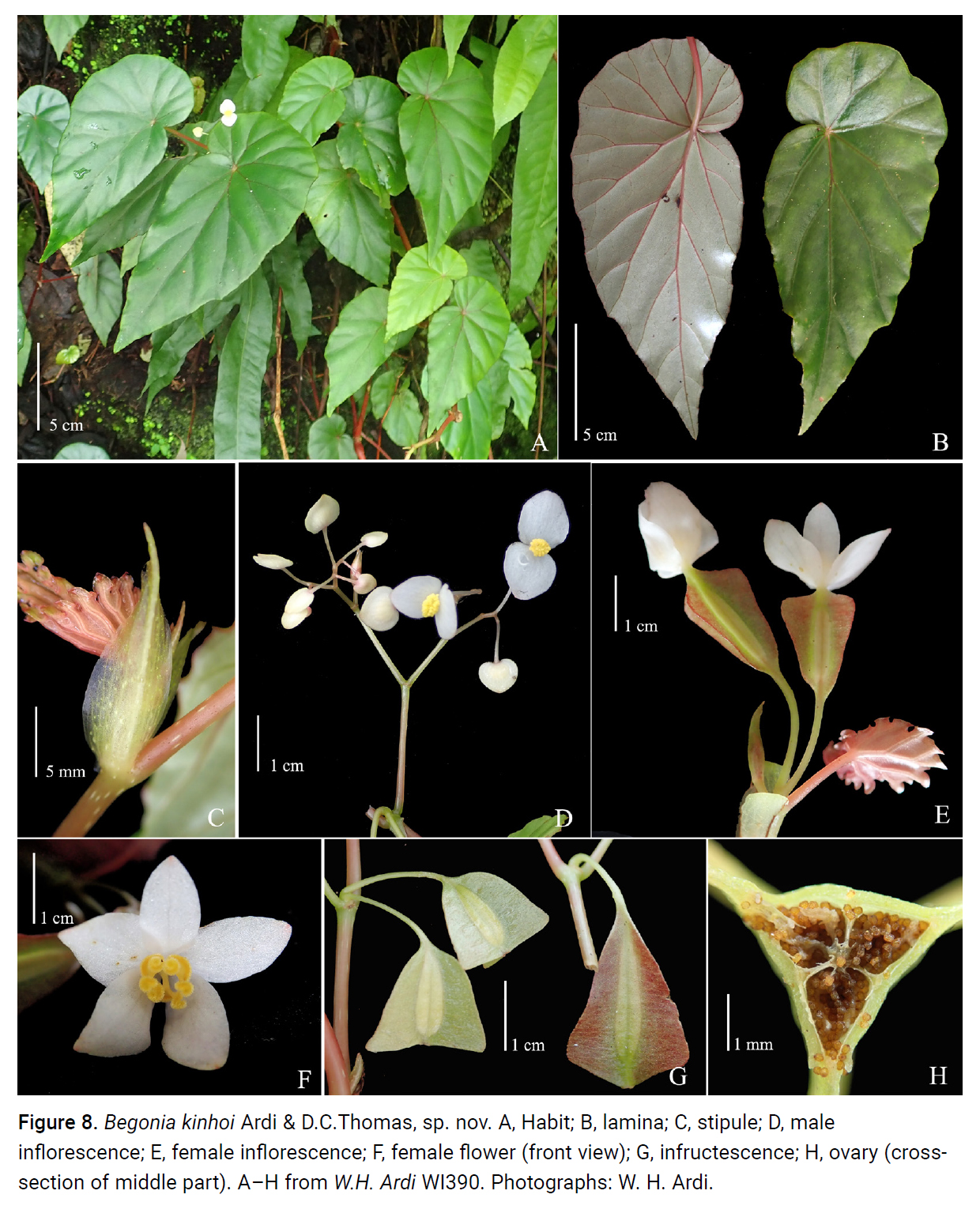Begonia kinhoi in Edinburgh J. Bot. 79(Begonia special issue, article 405): 25. 2022
Primary tabs

Diagnosis
- Most similar to Begonia macintyreana M.Hughes in its erect growth habit, glabrous stems and leaves, and compound thyrse with monochasial partial inflorescences, but it can be easily distinguished by the much shorter peduncles of the female inflorescences (c.1 mm long vs 14–20 mm long); smaller female flower tepals (12–16 × 7–9 mm vs c.20 × 13 mm) with rounded apex (vs apex acute); cylindrical ovary (vs ovary ellipsoid to obovoid); and longer, pendulous fruit pedicels, which are 13–23 mm long (vs fruit pedicel c.15 mm long, stiff and not pendulous). (Ardi, W.H. & Thomas, D.C. 2022: Synopsis of Begonia (Begoniaceae) from the northern arm of Sulawesi and Sangihe Island, Indonesia, including three new species. – Edinburgh J. Bot. 79(Begonia special issue, article 405): 1-50. https://doi.org/10.24823/EJB.2022.405)
Description
- Perennial, monoecious herb, erect, up to c.60 cm tall. Stem branched; internodes 3–13 cm long, swollen at the nodes, brownish-reddish, glabrous except for the microscopic glandular hairs. Leaves basifixed, alternate; stipules semi-persistent, 7–14 × 4–6 mm, ovate to oblong, with an abaxially slightly prominent midrib, apex narrowed into bristle projecting up to 3 mm, margin entire and recurved, pale green, translucent at the margin, abaxially hairy; petioles 3–9 cm long, terete, not channelled, concolorous with the stem, glabrous; lamina 9.5–19 × 3–7 cm, asymmetrical, ovate to elliptic, base cordate and lobes not or just slightly overlapping, apex acuminate, margin scalloped, denticulate, adaxial surface green, with red veins, glabrous, abaxial pale green, glabrous; venation palmate-pinnate, primary veins 6–8, actinodromous, secondary veins craspedodromous. Inflorescences protogynous; female inflorescences basal to male, 2-flowered, peduncles c.1 mm long; male inflorescence a compound thyrse with up to 3 lateral partial inflorescences (thyrses or the upper partial inflorescences developed as simple cymes), each with up to 3 monochasial cymes, each with 2–5 flowers, peduncle of partial inflorescence c.15 mm long, bracts caducous. Male flowers: pedicels 10–15 mm long, white-pinkish, glabrous; tepals 2, white to white tinged with pink, 7–11.5 × 6–11.5 mm, ovate to broadly ovate, base slightly cordate, apex obtuse, outer surface glabrous; androecium of c.75 stamens, yellow, filaments up to c.1 mm long, slightly fused at the very base, anthers up to c.1 mm long, oblong to narrowly obovate, dehiscing through unilaterally positioned slits that are c.1/2 as long as the anthers. Female flowers: pedicels 8–12 cm long, pale green, glabrous; tepals 5, white, subequal, 12–16 × 7–9 mm, ovate to elliptic, outer surface glabrous; ovary (excluding wings) 9–13 × 3–4.5 mm, cylindrical, pale green, glabrous, locules 3, placentation axile, placentae bilamellate, wings 3, equal, pale green, base mostly cuneate, sometimes rounded, apex truncate to subtruncate, up to 4 mm at widest point (apically or subapically); style c.3.5 mm long, basally fused, 3-branched, each stylodium bifurcate in the stigmatic region, stigmatic surface a spirally twisted papillose band, orange. Fruits: peduncles c.1 mm long; pedicels 13–23 mm long, pendulous; seed-bearing part cylindrical, 12–22 × 3.5–4.5 mm (excluding the wings), glabrous, dehiscent, splitting along the wing attachment, wing shape as for ovary, up to 10.5 mm at the widest point (apically or subapically). Seeds barrel-shaped, c.0.2 mm long. (Ardi, W.H. & Thomas, D.C. 2022: Synopsis of Begonia (Begoniaceae) from the northern arm of Sulawesi and Sangihe Island, Indonesia, including three new species. – Edinburgh J. Bot. 79(Begonia special issue, article 405): 1-50. https://doi.org/10.24823/EJB.2022.405)
Habitat & Ecology
- Strongly disturbed lowland to upland secondary forest at 350–900 m elevation. (Ardi, W.H. & Thomas, D.C. 2022: Synopsis of Begonia (Begoniaceae) from the northern arm of Sulawesi and Sangihe Island, Indonesia, including three new species. – Edinburgh J. Bot. 79(Begonia special issue, article 405): 1-50. https://doi.org/10.24823/EJB.2022.405)
Conservation
- Critically Endangered (CR), B2ab(iii). Begonia kinhoi is known from only two localities (Gunung Klabat and Gunung Lokon), and two small populations were observed on Gunung Klabat. The type locality is a popular mountaineering track in North Sulawesi. The forests of Gunung Klabat and Gunung Lokon have no legal status as protected areas, and potential threats, such as tourism and agriculture, were observed in the area. Gunung Klabat is relatively poorly collected, and this species is likely to have a wider range in the forests of Gunung Klabat and Gunung Lokon. However, even if this is the case, its small EOO and AOO, in combination with the observed threats and anthropogenic disturbances (including coconut and vegetable plantations) would still support a Critically Endangered status (IUCN Standards and Petitions Subcommittee, 2019). (Ardi, W.H. & Thomas, D.C. 2022: Synopsis of Begonia (Begoniaceae) from the northern arm of Sulawesi and Sangihe Island, Indonesia, including three new species. – Edinburgh J. Bot. 79(Begonia special issue, article 405): 1-50. https://doi.org/10.24823/EJB.2022.405)
Distribution (General)
- Indonesia: endemic to Sulawesi, North Sulawesi Province, Gunung Klabat, Gunung Lokon (Ardi, W.H. & Thomas, D.C. 2022: Synopsis of Begonia (Begoniaceae) from the northern arm of Sulawesi and Sangihe Island, Indonesia, including three new species. – Edinburgh J. Bot. 79(Begonia special issue, article 405): 1-50. https://doi.org/10.24823/EJB.2022.405)A
Etymology
- The specific epithet of Begonia kinhoi is in honour of Julianus Kinho, researcher at the Forestry Research Institute of Manado, North Sulawesi (Ardi, W.H. & Thomas, D.C. 2022: Synopsis of Begonia (Begoniaceae) from the northern arm of Sulawesi and Sangihe Island, Indonesia, including three new species. – Edinburgh J. Bot. 79(Begonia special issue, article 405): 1-50. https://doi.org/10.24823/EJB.2022.405)B
Specimens
- Additional specimen examined. Indonesia. Sulawesi. Northern arm of Sulawesi. Eastern North Sulawesi: Gunung Klabat, 30 i 2019, W.H. Ardi WI390 (BO, FIPIA, SING); Gunung Lokon, D. Girmansyah DG1298 (BO). (Ardi, W.H. & Thomas, D.C. 2022: Synopsis of Begonia (Begoniaceae) from the northern arm of Sulawesi and Sangihe Island, Indonesia, including three new species. – Edinburgh J. Bot. 79(Begonia special issue, article 405): 1-50. https://doi.org/10.24823/EJB.2022.405)

